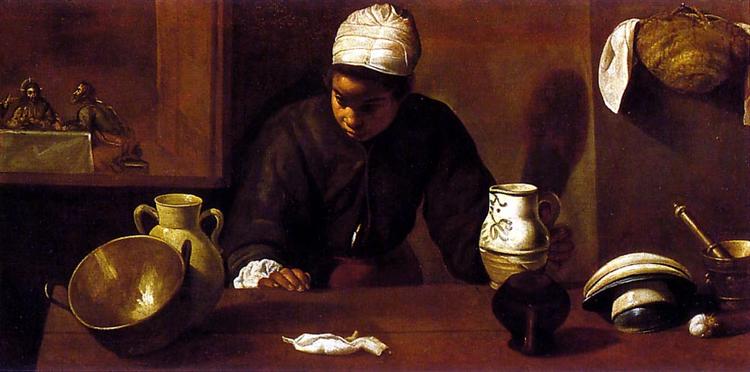
Kitchen Scene With The Supper In Emmaus Diego Velazquez (public Domain)
by Christine Sine
A couple of weeks ago our rector preached about the disciples meeting Jesus on the road to Emmaus. He began by talking about Diego Velázquez’s painting The Kitchen Maid. Here the two Emmaus disciples are vaguely seen in the background seated at the table with the Resurrected Christ. In the foreground, is a nameless servant girl, dark complexioned, obviously Middle Eastern, probably of low status, possibly a slave. Velázquez portrays her as the first in the house to recognize the risen Christ whom she is serving. What a moment! what an incredible revelation!
Some of us are quick to say “but it’s not Biblical” and it is true, there is no servant girl in the Biblical narrative but there must have been serving girls and kitchen maids. These were the women not usually noticed by men unless they were being blamed or used.
Yet I think Velázquez has it right. These are the ones to whom Jesus first appeared. There was Mary, the mother of Jesus, a young single pregnant woman who could have been stoned for her seeming indiscretion. There was Mary Magdalene whom we talked about last week, and the woman at the well that Jeannie Kendall reflected on.
The Biblical figure that comes most vividly to mind when I reflect on this painting is Mary the sister of Lazarus. She wanted to sit at Jesus feet and learn from him just as the men were able to learn, but even her sister Martha wanted to relegate her to the role of servant. (Luke 10:38-42) When Jesus says that Mary has chosen the one thing that matters he is really becoming an advocate for bringing women out of the shadows into the place of education. Basically he is saying: Mary wants to learn from me, just as the men do, that is all that really matters for both men and women.
It seems to me that the young kitchen maid represents all the women throughout history that Jesus has liberated from slavery, abuse and inequality. These women are often the first to recognize the risen Christ, yet we so often try to push them back into the places of slavery. The domination of women by men was a consequence of the fall and the brokenness of humankind. (Genesis 3:16). Yet our society and many of our churches seem to want to maintain this brokenness. Men still want to dominate women and we let it happen. From the sex trade to unequal wages, from the refusal to allow women in leadership to the lack of maternity leave, the rules are still against equality for women. Women as sex symbols still sell everything from cars to shampoo. Some even believe that because the Bible has been translated by men over most of its history, discrimination has been perpetuated in our interpretations.
I love the way The Voice translates Adam’s response to the creation of Eve in Genesis 2:23 At last, a suitable companion, a perfect partner. Bone from my bones. Flesh from my flesh. My husband says that not treating me as an equal diminishes him. Not allowing the gifts God has given me to fully develop is like cutting off one of his arms or a leg.
What Is Your Response?
This post is part of a series I felt God prompt me to write on women in the Bible and in the church. Recovering God’s perspective of freedom and equality as it relates to the relationships between men and women has been liberating for me and I know that it is time for me to speak out more strongly. Like most women in the church I am still confronted with inequality at times, but have the privilege of freedom in ways that many women will never have. I still remember the medic in the refugee camps in Thailand who said” You give me hope that one day my daughters will have the same freedom you do.”
Which scriptures come to mind when you think about God’s view of women and their place in the church? How have you been an advocate for equality? Are there ways that God might ask you too to speak out more strongly in support of those who are still pushed into the shadows?

4 comments
I’ve always been intrigued by “the other disciple” who accompanied Cleopas. Sometimes, in my Ignatian imagination, I place myself in that role. — Who’s to say it was a man?
And, not related to womanliness, when doing a Labyrinth Walk themed to Emmaus, the questions came to me:
Who do I CHOOSE as companions for the Journey?
Who does God send to companion me?
And, finally, am i LISTENING to them???
A beautiful response Bee Jay
Thank you for this thoughtful piece. I love this story and I have never seen this painting before. We don’t really know the gender of the companion of Cleopas. I have wondered (I don’t think I am the only one) if Cleopas’ companion is his wife. I now have a hard time picturing the story any other way. Thanks again!
Your right Shawn, I love to think it was Cleopas’ wife too, though most of the art work we see of this story is of 2 men and from what I understand that is more likely.